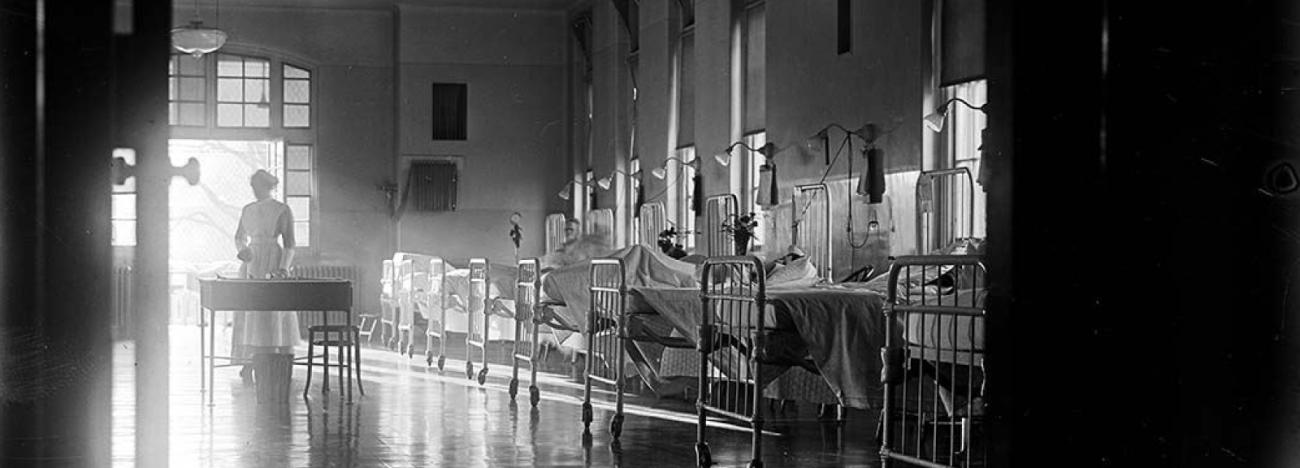UBC and the last great pandemic, 1918-19
Businesses, educational institutions, and many other establishments have closed or at least severely limited public access. Hospitals are struggling to deal with waves of sick individuals, with other facilities being converted into makeshift hospitals. Citizens are being told to stay home as much as possible, and to avoid gathering in groups. Everybody is listening to news reports from foreign countries documenting mounting death tolls and rising social tensions, while waiting with a growing sense of dread for the situation at home to get worse.
While this sounds like the current COVID-19 epidemic, the situation described applies to a similar crisis that hit Vancouver and UBC over a century ago: the great influenza epidemic of 1918-19 (aka the “Spanish flu”), which afflicted the entire world as the First World War was drawing to a close.
The first case of influenza was reported in Vancouver on October 5, 1918; the first death was recorded on the 10th. The number of daily reported cases spiraled upwards rapidly, reaching 522 on October 22, while the death rate peaked on October 27, when 24 people succumbed to the effects of the virus.
Life on the original UBC Fairview campus (where Vancouver General Hospital stands today) began to change within a few days of the local appearance of the flu virus. By October 14 local hospitals had become so overcrowded that the Auditorium and an adjacent classroom building were taken over by VGH. An improvised hospital ward with 100 beds was quickly set up, exclusively for influenza cases, and access to students and all other non-medical personnel was cut off.
The Board of Governors declared that they had “consented to this occupation on the representation of the city health officer and of the hospital board that such additional accommodation in the vicinity of the hospital is absolutely necessary in the present situation, and their assurance that the use of the buildings for this purpose will not be a source of danger to the students…” (The Province, October 14, 1918).
The closure would last five weeks, forcing the re-vamping of the entire academic calendar…. When the war ended on November 11, there was no opportunity for the university community, born in war-time only three years earlier, to celebrate.
Closure of the Auditorium forced the relocation of several classes. Some were moved to the local Baptist church, others to the science drafting room, and one was even held in the stack room of the Library. Students’ Council meetings had to be held in a corridor, among stacked furniture removed from the council room. By the 18th, a meeting of the student body had passed a resolution asking the Board of Governors to close the university until conditions improved.
The announcement that university classes would be suspended due to the epidemic was made on October 20. The closure would last five weeks, forcing the re-vamping of the entire academic calendar. Christmas exams would eventually be delayed until February, and the second term extended by two weeks. All student activities, such as sporting events, theatre productions, and publication of the Ubyssey, were also cancelled. When the war ended on November 11, there was no opportunity for the university community, born in war-time only three years earlier, to celebrate.
Not only were regular classes disrupted by the epidemic – other educational groups based on the campus saw their activities interrupted as well. These included the Vancouver Institute, which had to cancel or re-schedule several lectures that fall, and the Vancouver Natural History Society. Evening classes in botany were also postponed indefinitely.
Although classes and social activities were suspended, UBC students and staff did not remain idle. Some served as orderlies at the hospital, while others worked for the city relief offices and other organizations helping citizens cope during the crisis.
The women of the student Red Cross Society, led by Modern Languages instructor Isabel MacInnes, volunteered as nurses in the VGH influenza ward. Some of them also found time to make over 300 flu masks and sew 65 pairs of pajamas. The demonstrated importance of nurses in the treatment of flu patients, whether trained professionals or volunteers, would serve as an impetus to the establishment of UBC’s nursing program in 1919.
The demonstrated importance of nurses in the treatment of flu patients, whether trained professionals or volunteers, would serve as an impetus to the establishment of UBC’s nursing program in 1919.
Many students became sick, either during the virus’s first devastating onslaught that fall, or in one of the epidemic’s later waves. Three students died: H.G. (Horace) Stedman, Wilfrid Moore, and David W. Murray. A fourth, Gerald M. “Shorty” Harvey, had enlisted in the armed forces and died from influenza during basic training. All were eulogized in the 1919 Annual as “brilliant… promising young men” whose deaths were “deeply felt by students and faculty alike.” Enrollment still numbered only several hundred, and the university was a close-knit community. The deaths of these young men, seemingly spared the horrors of war only to be cut down by disease, affected everybody especially hard.
After the epidemic’s peak in late October, the infection and death rates went into steep decline, and the flu had seemingly all but disappeared by the end of November. Classes resumed on November 26, and within a week academic and social activities had returned to near-regular routines.
However, the epidemic would soon return: two more waves followed, peaking in January and March, both of which were less extensive than the original outbreak, but with a relatively higher fatality rate.
And then it was over. Students were left to look back upon what they had survived, and what they had accomplished. As noted in the foreword of the 1919 Annual, with just a hint of stiff-upper-lipped understatement:
“The work of all classes was much disorganised and everyone felt a little out of poise. But it has been highly pleasing to see the mutual feeling between the Faculty and student body in attempting to regain that which was lost, and to make the present count for the most.”
Hopefully, once the current COVID-19 epidemic has subsided, today’s UBC community will be able to look back with similar sentiments.
Sources:
Tuum Est by Harry T. Logan (1958)
UBC Scrapbooks (1890-1941) – clippings from local newspapers
1919 Annual
Andrews, Margaret W., “Epidemic and Public Health: Influenza in Vancouver, 1918-1919”, BC Studies, No. 34, Summer 1977.






























